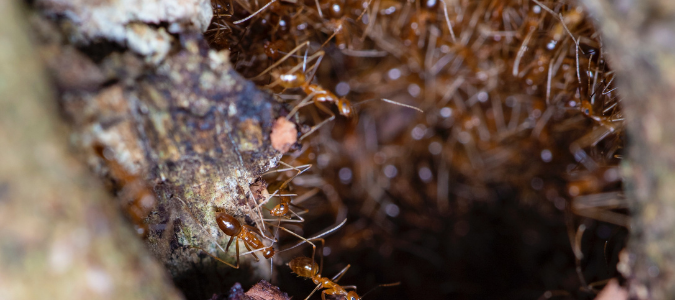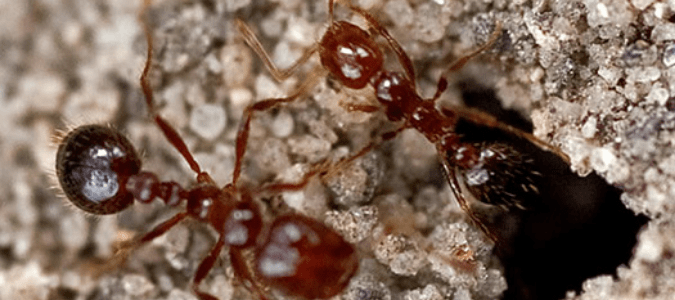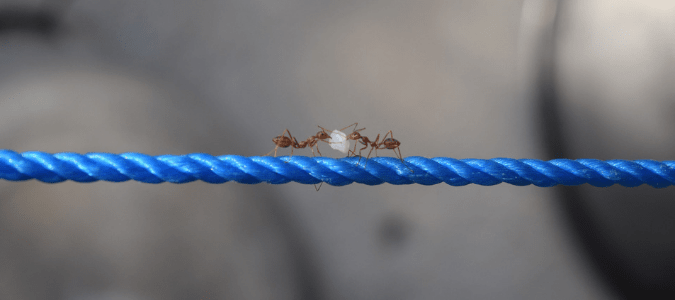Identifying Pharaoh Ants Versus Fire Ants

Identifying Pharaoh Ants Versus Fire Ants
Pharaoh ants, pictured above, are tiny ants, measuring less than one-sixteenth of an inch in length. They are yellowish with a dark-tipped gaster, the bulbous posterior portion of the abdomen. They have two pedicels, or nodes, connecting their abdomen and gaster. All workers within a pharaoh ant colony are the same size.
Fire ants, specifically red imported fire ants, are medium-sized red and black-colored ants. They typically measure between one-sixteenth and a quarter of an inch in length. Fire ants are known for their aggressive behavior and painful stings when disturbed. They build mounds of soft soil, rarely larger than 18 inches in diameter, with no central openings.
Pharaoh Ant Versus Fire Ant Appearance
Pharaoh ants have distinct features that can help homeowners identify them. First, their antennae have a long first segment, creating an elbow-like bend. They also have a characteristic waist, called a pedicel, that connects the thorax and abdomen.
Along with their color, there are several other ways to tell fire ants apart from pharaoh ants. Fire ants have a double pedicel and a smooth, curved thorax. Workers within a fire ant colony vary, with the largest workers being two or three times larger than the smallest.

Pharaoh Ant Versus Fire Ant Nesting Habits
When it comes to nesting, pharaoh ants are known to hide out in dark, narrow spaces. They live both indoors and outdoors and are often found nesting in cardboard boxes, electrical boxes, wall voids and other small crevices.
Fire ants, pictured above, primarily nest outdoors, creating their mounds in soil. The mounds are usually built in open, sunny areas and can cause damage to lawns and gardens. Fire ants may enter buildings for food and water, but only out of necessity.
Pharaoh Ant Versus Fire Ant Diet
Pharaoh ants are particularly picky eaters, alternating between foods high in sugar and protein. They are known to infest indoor spaces, especially for food and shelter.
Unlike pharaoh ants, fire ants are not picky about their diet. They will eat anything that gives them protein, including dead insects, grasshoppers, fly larvae, caterpillars, moths and other ants. In fact, they are known for wiping out other native ant species.
Pharaoh Ant Versus Fire Ant Behavior
Thankfully, pharaoh ants are not known for being aggressive and do not sting. However, they can become a major nuisance when living in your house or property. They are known for gnawing through fabrics such as silk and rayon. They can also chew holes through plastic materials.
Fire ants emerge aggressively when disturbed, crawling up vertical surfaces, biting and stinging simultaneously. Their sting typically leaves itchy circular welts that turn into blisters.
Pharaoh Ant and Fire Ant Control
Whether pharaoh ants or fire ants are infesting your property, both pests can become a major annoyance. The best way to manage an ant infestation is to call a professional pest control service. An expert will have the knowledge and experience to know how to best control the infestation.

Are Ants Active at Night?
There are over 12,000 species of ants, and most ants are diurnal, meaning they are only active during the day. However, there are some nocturnal ant species. They also happen to be the species homeowners are likely to see scurrying around their homes at night.
Ant species sometimes active at night include red imported fire ants, carpenter ants, acrobat ants, army ants and pavement ants. Some species are inactive during the day and active at night. However, some ants are active during daytime and nighttime, such as pharaoh ants and odorous ants.
There are several reasons why some ants adapt to become nocturnal. First, temperatures are milder at night. In areas with extreme heat and humidity, ants cannot forage for food and maintain their nests during the daytime.
Next, ants have more food security at night because they can feed on other nocturnal creatures and avoid competition with diurnal ants. Lastly, ants that are active at night can avoid threatening diurnal predators, such as birds and lizards. Being active at night gives ants a better chance at survival.
Making Your Home Less Hospitable to Ants
Whether you are dealing with ants that are active during the daytime or nighttime, they can become a major nuisance. Luckily, there are ways that homeowners can make their homes less hospitable to these unwelcome guests.
First, inspect your home for potential entry points and seal them up. This includes holes and cracks in your doors, windows, foundation and other areas where ants could enter. Do not overlook any spots where utility lines enter your home because ants only need a tiny opening to make their entrance.
You should also trim back any plants or trees that touch the exterior of your house. Ants often use them as a bridge to get inside your home.
Keeping a tidy home is the next best way to deter ants from taking up residence. Wipe down your kitchen counters daily and clean up crumbs and spills. To keep ants out of your food, store everything in airtight containers. Regularly sweeping and vacuuming your floors is also a good idea.
Ants are attracted to moisture, so it’s important not to let standing water linger in your home. Stay on top of your plumbing to prevent any leaks or drainage issues. Do not leave water in your sinks and be mindful about leaving water in pet bowls or plant trays.
Next, ensure all your garbage, recycling and compost bins have airtight lids. Open bins are a feasting ground for ants. Take out your waste regularly.
If you are already dealing with an ant infestation, the best way to get your home back is to call a professional pest control service.

What to Do About Ants in the Dishwasher
Unfortunately, it’s common to find ants in the dishwasher because these appliances make ideal homes for ants. They provide plenty of moisture and food residue for ants to eat. If you spot ants in your dishwasher, there are several simple ways to kick them out.
First, look for potential entry points. Gaps in the floor, walls or cabinets around the dishwasher often offer ants easy access. Once you find where the ants are getting into the dishwasher, seal up the area with caulk or weatherstripping.
Next, thoroughly clean out your dishwasher. Try flushing the drain with vinegar and baking soda. You should also clean the filter and strainer with vinegar or mild dish soap.
Rinsing your dishes before you put them into the dishwasher will provide less food residue for ants to feast on.
Ant infestations are best treated by professionals. If you see ants in your dishwasher, contact a pest control service.
How to Prevent an Ant Infestation
Understanding the differences between pharaoh ants and fire ants can help you identify which species is causing problems in your living space. Remember that both species may be active at night.
When you are inspecting your home for ants, don’t forget to check the dishwasher since it is a haven for ant activity. If ants are causing problems in your home, contact pest control professionals.
Chem-Free Can Treat the Ants on Your Property
Trying to control an ant problem while also taking into account your kids and pets can be difficult. When you contact Chem-free Pest Control, you can have peace of mind that we will create a custom pest control solution that keeps all of your family members in mind. Once we have treated the ants on your property, we will leave you with green tips on how to prevent future encounters with these pests.
Need Help Managing Pests?
Chem-Free offers both effective, low-impact pest control options and preventative measures to help avoid future infestations. Contact us today for a free estimate!


